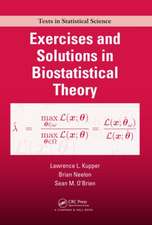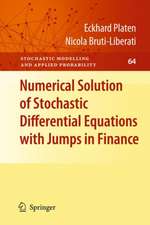Design and Analysis of Experiments: Springer Texts in Statistics
Autor Angela M. Dean, Daniel Vossen Limba Engleză Hardback – 20 dec 2000
| Toate formatele și edițiile | Preț | Express |
|---|---|---|
| Paperback (1) | 425.09 lei 6-8 săpt. | |
| Springer – 16 mar 2013 | 425.09 lei 6-8 săpt. | |
| Hardback (1) | 626.93 lei 38-44 zile | |
| Springer – 20 dec 2000 | 626.93 lei 38-44 zile |
Din seria Springer Texts in Statistics
-
 Preț: 400.60 lei
Preț: 400.60 lei - 15%
 Preț: 559.21 lei
Preț: 559.21 lei - 18%
 Preț: 903.62 lei
Preț: 903.62 lei - 20%
 Preț: 764.93 lei
Preț: 764.93 lei - 20%
 Preț: 643.55 lei
Preț: 643.55 lei - 20%
 Preț: 717.71 lei
Preț: 717.71 lei - 13%
 Preț: 487.08 lei
Preț: 487.08 lei - 20%
 Preț: 633.82 lei
Preț: 633.82 lei - 20%
 Preț: 697.48 lei
Preț: 697.48 lei - 15%
 Preț: 676.86 lei
Preț: 676.86 lei - 15%
 Preț: 621.10 lei
Preț: 621.10 lei - 20%
 Preț: 700.51 lei
Preț: 700.51 lei - 18%
 Preț: 743.11 lei
Preț: 743.11 lei - 18%
 Preț: 695.29 lei
Preț: 695.29 lei -
 Preț: 253.64 lei
Preț: 253.64 lei - 17%
 Preț: 525.27 lei
Preț: 525.27 lei - 17%
 Preț: 428.39 lei
Preț: 428.39 lei - 19%
 Preț: 571.81 lei
Preț: 571.81 lei - 20%
 Preț: 567.30 lei
Preț: 567.30 lei -
 Preț: 359.54 lei
Preț: 359.54 lei -
 Preț: 477.28 lei
Preț: 477.28 lei - 20%
 Preț: 570.35 lei
Preț: 570.35 lei - 15%
 Preț: 650.86 lei
Preț: 650.86 lei - 18%
 Preț: 948.29 lei
Preț: 948.29 lei -
 Preț: 500.46 lei
Preț: 500.46 lei - 18%
 Preț: 746.59 lei
Preț: 746.59 lei -
 Preț: 403.75 lei
Preț: 403.75 lei -
 Preț: 403.37 lei
Preț: 403.37 lei -
 Preț: 394.71 lei
Preț: 394.71 lei - 18%
 Preț: 946.69 lei
Preț: 946.69 lei - 15%
 Preț: 578.67 lei
Preț: 578.67 lei - 15%
 Preț: 702.54 lei
Preț: 702.54 lei -
 Preț: 407.01 lei
Preț: 407.01 lei - 18%
 Preț: 895.89 lei
Preț: 895.89 lei - 15%
 Preț: 600.80 lei
Preț: 600.80 lei - 23%
 Preț: 684.78 lei
Preț: 684.78 lei - 19%
 Preț: 543.08 lei
Preț: 543.08 lei - 15%
 Preț: 595.86 lei
Preț: 595.86 lei -
 Preț: 423.18 lei
Preț: 423.18 lei - 15%
 Preț: 656.10 lei
Preț: 656.10 lei - 15%
 Preț: 682.90 lei
Preț: 682.90 lei - 18%
 Preț: 814.43 lei
Preț: 814.43 lei -
 Preț: 402.76 lei
Preț: 402.76 lei -
 Preț: 408.54 lei
Preț: 408.54 lei
Preț: 626.93 lei
Preț vechi: 774.00 lei
-19% Nou
Puncte Express: 940
Preț estimativ în valută:
119.98€ • 130.28$ • 100.78£
119.98€ • 130.28$ • 100.78£
Carte tipărită la comandă
Livrare economică 18-24 aprilie
Preluare comenzi: 021 569.72.76
Specificații
ISBN-13: 9780387985619
ISBN-10: 0387985611
Pagini: 742
Dimensiuni: 191 x 235 x 40 mm
Greutate: 1.59 kg
Ediția:1st ed. 1999. Corr. 2nd printing 2000
Editura: Springer
Colecția Springer
Seria Springer Texts in Statistics
Locul publicării:New York, NY, United States
ISBN-10: 0387985611
Pagini: 742
Dimensiuni: 191 x 235 x 40 mm
Greutate: 1.59 kg
Ediția:1st ed. 1999. Corr. 2nd printing 2000
Editura: Springer
Colecția Springer
Seria Springer Texts in Statistics
Locul publicării:New York, NY, United States
Public țintă
GraduateDescriere
Our initial motivation for writing this book was the observation from various students that the subject of design and analysis of experiments can seem like “a bunch of miscellaneous topics. ”Webelievethattheidenti?cationoftheobjectivesoftheexperimentandthepractical considerations governing the design form the heart of the subject matter and serve as the link between the various analytical techniques. We also believe that learning about design and analysis of experiments is best achieved by the planning, running, and analyzing of a simple experiment. With these considerations in mind, we have included throughout the book the details of the planning stage of several experiments that were run in the course of teaching our classes. The experiments were run by students in statistics and the applied sciences and are suf?ciently simple that it is possible to discuss the planning of the entire experiment in a few pages, and the procedures can be reproduced by readers of the book. In each of these experiments, we had access to the investigators’ actual report, including the dif?culties they came across and how they decided on the treatment factors, the needed number of observations, and the layout of the design. In the later chapters, we have included details of a number of published experiments. The outlines of many other student and published experiments appear as exercises at the ends of the chapters. Complementing the practical aspects of the design are the statistical aspects of the anal ysis. We have developed the theory of estimable functions and analysis of variance with somecare,butatalowmathematicallevel.
Cuprins
Principles and Techniques.- Planning Experiments.- Designs with One Source of Variation.- Inferences for Contrasts and Treatment Means.- Checking Model Assumptions.- 6 Experiments with Two Crossed Treatment Factors.- Several Crossed Treatment Factors.- Polynomial Regression.- Analysis of Covariance.- Complete Block Designs.- Incomplete Block Designs.- Designs with Two Blocking Factors.- Confounded Two-Level Factorial Experiments.- Confounding in General Factorial Experiments.- Fractional Factorial Experiments.- Response Surface Methodology.- Random Effects and Variance Components.- Nested Models.- Split-Plot Designs.
Recenzii
This is a readable book presenting the basic concepts, principles, and techniques of design and analysis of experiments. Written with a view to making it accessible to a wide audience, the authors make concerted efforts to avoid using calculus and linear algebra and, wherever needed, a low mathematical level is used for presentation. Rather than performing exploratory data analysis, the concentration here is on the use of prespecified models and preplanned analyses. Model assumptions are clearly stated, and checked through the use of residual plots rather than formal tests. All analyses are presented by using standard linear models under the assumption of normality. It is the experimentwise control of the error rate and confidence levels on which the presentation is focused as opposed to individual error rates and confidence levels. The popular "Taguchi techniques", used extensively in an industrial set-up, are included and appear throughout several chapters.
The book contains enough material for an instructor to offer a course ranging from one semester to one year. An attractive feature of this book is the inclusion of numerous real experiments which were either run by students or extracted from published articles---thus bringing home to students the practical utility of statistical designs. The authors have done a commendable job in presenting, explaining, and elucidating the fundamental concepts of design and analysis of experiments through illustrative examples. A carefully selected set of exercises is provided at the end of each chapter for students to test their understanding of the material.
--Mathematical Reviews
The book contains enough material for an instructor to offer a course ranging from one semester to one year. An attractive feature of this book is the inclusion of numerous real experiments which were either run by students or extracted from published articles---thus bringing home to students the practical utility of statistical designs. The authors have done a commendable job in presenting, explaining, and elucidating the fundamental concepts of design and analysis of experiments through illustrative examples. A carefully selected set of exercises is provided at the end of each chapter for students to test their understanding of the material.
--Mathematical Reviews
Caracteristici
Provides a comprehensive introduction to modern experimental design
Offers a step-by-step guide to the planning process, including a planning checklist, and emphasizes practical considerations
A wide variety of experiment designs are presented
Nearly all data sets in the book have been derived from real experiments
Details of the planning stage of numerous different experiments are discussed
Explains all the basics of analysis including estimation of treatment contrasts and analysis of variance, and applies these in a wide variety of settings
Sample SAS programs are included
Offers a step-by-step guide to the planning process, including a planning checklist, and emphasizes practical considerations
A wide variety of experiment designs are presented
Nearly all data sets in the book have been derived from real experiments
Details of the planning stage of numerous different experiments are discussed
Explains all the basics of analysis including estimation of treatment contrasts and analysis of variance, and applies these in a wide variety of settings
Sample SAS programs are included












